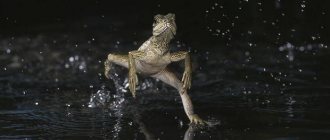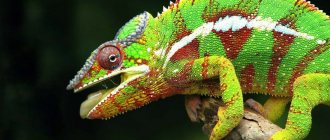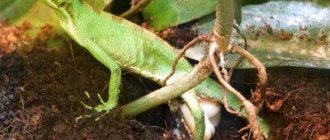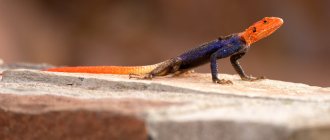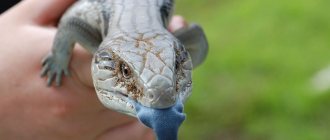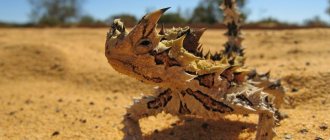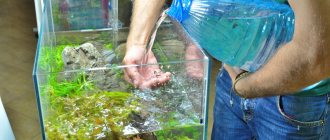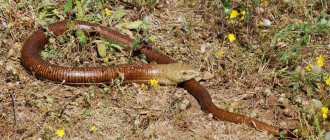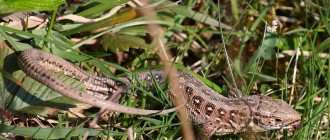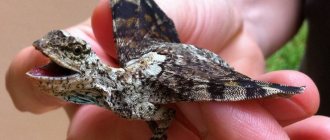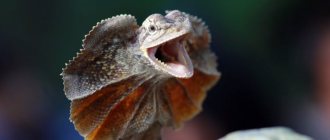The helmeted basilisk (lat. Basiliscus plumifrons) is one of the most unusual lizards that can be kept in captivity. Bright green in color, with a large crest and unusual behavior, it resembles a miniature dinosaur. But, at the same time, a fairly spacious terrarium is needed for maintenance, and it is nervous and completely tame. Although this reptile is not for everyone, with good care it can live quite a long time, longer than 10 years.
Habitat in nature
The habitat of the four existing species of basilisks is located in Central and South America, from Mexico to the coast of Ecuador.
The helmeted one lives in Nicaragua, Panama and Ecuador.
They live along rivers and other water basins, in places abundantly heated by the sun.
Typical places are thickets of trees, dense reeds and other thickets of plants. In case of danger, they jump from branches into the water.
Helmeted basilisks are very fast, they run superbly and can reach speeds of up to 12 km/h, and can also dive under water in times of danger.
They are quite common and do not have any special conservation status.
- The average size is 30 cm, but larger specimens are also found, up to 70 cm. Life expectancy is about 10 years.
- Like other types of basilisks, helmeted ones can run on the surface of the water for considerable distances (400 meters) before plunging into it and swimming. For this feature they are even called “Jesus lizard”, alluding to Jesus, who walked on water. They can also stay underwater for about 30 minutes to wait out danger.
- Two-thirds of the basilisk is the tail, and the crest on the head serves to attract the attention of the female and for protection.
Basilisk runs in the water:
Types of basilisks
Scientists call basilisks large lizards that grow up to one meter long. But, despite such parameters, the individual itself is small because only one third of the animal is its body. Everything else is a long basilisk tail.
They are divided into four types, which differ in color, size and place of residence.
— The common or helmeted basilisk inhabits the Center of America and Colombia.
- Double-crested basilisk - lives in Panamanian and Costa Rican forests.
— The Mexican striped basilisk is native to Mexico and Colombia.
— Crested basilisk , it lives in the Panamanian, western Colombian and Ecuadorian tropical forests.
Maintenance and care
In nature, at the slightest danger or fear, they take off and run away at full speed, or jump from branches into the water. In a terrarium, they can crash into glass, which is invisible to them.
So it's a good idea to keep them in a terrarium with opaque glass, or cover the glass with paper. Especially if the lizard is young or caught in the wild.
A terrarium measuring 130x60x70 cm is sufficient for only one individual; if you plan to keep more, then choose a more spacious one.
Since they live in trees, there should be branches and snags inside the terrarium that the basilisk can climb. Live plants are also good, as they shelter and camouflage the lizard, and help maintain air humidity.
Suitable plants are ficus, dracaena. It is better to plant them so that they create a shelter where the timid basilisk will be comfortable.
Males cannot tolerate each other, and only individuals of different sexes can be kept together.
Description and character of the basilisk lizard
These lizards live in the countries of Mexico and America. They are inhabitants of tropical rainforests and spend all their free time sitting on trees and bushes that grow near water. They also love to bask in the sun, climbing on a stone or dry branch.
Females and males of basilisks differ slightly in appearance. For example, a female is smaller than her male. A large fold of skin in the form of a triangular ridge grows on the head of male basilisks; in females it is practically invisible.
The crest also grows along the entire length of the back and up to half of the tail. Nature gave them such differences for a reason. Males actively guard their possessions, so they wear this outfit to intimidate uninvited guests.
If the male encounters a stranger on his territory, he inflates the skin pouch located on his throat, showing his aggression and superiority over the enemy.
For females, everything is different; like all women, they like to gather in a group around some enviable groom and wash all his bones. And their instinct of self-preservation is more pronounced; girls prefer to remain invisible, disguising themselves as some kind of twig.
Lizards live in families; one male, as a rule, has two or three females, but nothing more, otherwise the women will not get along. Families of lizards live in one place and do not migrate anywhere.
Basilisks have very long fingers and large claws at the ends of their fingers. They need claws of this length to move freely through trees and bushes, and to sit on a branch for a long time, firmly grasping it.
These ancient animals weigh from two hundred grams to half a kilogram. But there are also larger specimens. The color of basilisks can be grassy green, or light brown with an olive tint.
Zoologists have noticed that lizards bred in captivity differ in color, with turquoise shades predominating. Their belly is white, and light spots are visible along the back.
Although these lizards have a slightly unpleasant appearance, they are very timid by nature. And as soon as they feel alarm and danger, they immediately start to run away.
But this is only if they are not far from the water. And if there is no rescue reservoir nearby, they have no choice but to fall through the ground, that is, bury themselves in it.
They hide in the forest floor of fallen leaves, rotten twigs and branches, or instantly burrow into the sand. To prevent sand from getting into the animal's nostrils, it has special protective partitions there that slam shut at the right moment and block all exits and entrances.
And like this, with its nostrils closed and completely immobilized, the lizard can remain for a long time until it is completely sure that nothing threatens its life.
They breed all year round, females lay eggs several times with an interval of three to four months between clutches. One clutch can contain up to ten eggs.
After two and a half months, the offspring are born, but they immediately have to leave their parental home and look for a place to live. Otherwise, the basilisk predator can easily eat its child.
Basilisks have many enemies in the water, on land and in the air. And if they can notice fish and birds and hide somewhere in the thickets, then lizards suffer the most from some mammals that are nocturnal.
Substrate
Various types of soil are acceptable: mulch, moss, reptile mixtures, rugs. The main requirement is that they retain moisture and do not rot, and are easy to clean.
The soil layer is 5-7 cm, usually this is enough for plants and to maintain air humidity.
Sometimes, basilisks begin to eat the substrate, if you notice this, then replace it with something completely inedible. For example, a reptile mat or paper.
Reproduction
The mating season begins with the arrival of the rainy season. At this time, air humidity rises to 80% and after the drought, the desired coolness sets in. In the third week of pregnancy, the female looks for a secluded place to lay eggs. To do this, she descends from the tree to the ground.
The female methodically presses her muzzle to the soil in search of the most favorable temperature and soil moisture for incubating eggs. Having found a suitable place, she lays 15-17 eggs, 2.1 to 2.4 cm long and 1.2 to 1.5 cm wide, burying them in the sand. During one season, each female is able to lay several clutches.
Incubation lasts 8-10 weeks, after which small lizards approximately 11 cm long are born.
They pierce the shell with a special egg tooth, which later falls out. The first days of their lives, the cubs do not hunt, feeding exclusively on the contents of the yolk sacs. When food supplies run out, they go on the first hunt in their lives.
They grow quickly and already at the age of 5 months the males begin to fight among themselves for a place in the sun. Lizards become sexually mature only at 18-24 months of age.
Lighting
The terrarium needs to be illuminated using UV lamps 10-12 hours a day. The UV spectrum and daylength are critical for reptiles as they help them absorb calcium and produce vitamin D3.
If a lizard does not receive the required amount of UV rays, it may develop metabolic disorders.
Please note that the lamps must be changed according to the instructions, even if they do not fail. Moreover, these should be special lamps for reptiles, and not for fish or plants.
All reptiles should have a clear separation between day and night, so lights should be turned off at night.
Physiology [edit]
Basilisks average 70 to 75 cm (28 to 30 in) in total length (including the tail). Their growth is constant, rapid when young and non-linear for mature basilisks. [ citation needed
] Their long, comb-like sails, reinforced at three different points (head, back and tail),[
citation needed
] give the impression of creatures such as
Dimetrodon
and
Edaphosaurus
.
Their skin crumbles into pieces. [ citation needed
]
Heating
Native to Central America, basilisks can nevertheless tolerate fairly cold temperatures, especially at night.
During the day, there should be a heating point in the terrarium, with a temperature of 32 degrees, and a cooler part, with a temperature of 24-25 degrees.
At night the temperature can be around 20 degrees. For heating, you can use a combination of lamps and other heating devices, such as heated stones.
Be sure to use two thermometers, one in a cool corner and one in a warm corner.
Breeding in captivity
The helmeted basilisk becomes sexually mature at the age of 1.5-2 years. Basilisks can breed all year round. Females are capable of laying several clutches per year, which consist of 8-18 eggs. The female's pregnancy lasts approximately 2 months, after which she lays eggs. All eggs laid are covered with a leathery shell and should have an even white color.
It is necessary to closely monitor the females, and if they increase in size in the abdominal area, then a container should be placed in the terrarium. It is recommended to choose a plastic container, about 20 cm high. At the bottom of the container you need to put a layer of sand, 2 cm thick, and a layer of moss, 6 cm thick. The substrate in the masonry container must always be moistened. As soon as the female has finished laying and weaned, she can be transferred to the incubator. The incubation process lasts 26-31 days, at a constant temperature of 26-34 ° C. The helmeted basilisk does not have the instinct to care for offspring, and therefore young individuals cannot be left in the terrarium with adults, as they can be eaten by their parents.
After hatching, the offspring of helmeted basilisks can not be fed for two days, since during this time they absorb the protein obtained from the egg. After which you can start offering them small crickets, flies, maggots and a crushed mixture of bananas, pears and apples. Small basilisks prefer to stay in thickets near water. They are very careful, timid and agile - this is what saves them in the wild from numerous enemies.
Water and humidity
In nature they live in a fairly humid climate. In the terrarium, the humidity should be 60-70% or slightly higher. To maintain it, the terrarium is sprayed with water daily, monitoring the humidity using a hydrometer.
However, too high humidity is also bad, as it promotes the development of fungal infections in lizards.
Basilisks love water and are excellent dives and swimmers. Constant access to water, a large body of water where they can splash, is important for them.
It could be a container, or a special waterfall for reptiles, that’s not the point. The main thing is that the water is easily accessible and changed daily.
Basilisk at home
The main thing you need to know when buying a lizard is that it is domestic. An individual caught by poachers and brought in later has very little chance of survival. During catching and transportation, she suffered enormous stress and, as a result, all the animal’s diseases worsened.
The terrarium should be voluminous and tall; its optimal size for one individual is two hundred liters. You need to plant a lot of greenery in the basilisk's new home; they will really like a ficus tree or dracaena.
Don’t forget about dry tree branches, snags and stumps, on which the lizard will warm its body under the lamp. It would be nice to install a pool; you can use a smaller aquarium.
It is already known that basilisks are shy, so the walls of the terrarium should be visible to the lizard. Use paper to cover the outside of them, or tint the windows with something.
Otherwise, following its instincts, frightened, the lizard will start to run and then it will definitely break against the glass wall, since it is not visible to the animal.
It is very important that basilisks live in pairs, but under no circumstances should you house two males. They will fight among themselves until one is left.
Feeding
Helmeted basilisks eat a variety of insects: crickets, zoophobus, mealworms, grasshoppers, cockroaches.
Some eat naked mice, but these should only be given occasionally. They also eat plant foods: cabbage, dandelions, lettuce and others.
They need to be cut first. Adult basilisks need to be fed plant foods 6-7 times a week, or insects 3-4 times. Young, twice a day and insects. The food should be sprinkled with reptile supplements containing calcium and vitamins.
Links[edit]
- Wilson, L.D.; Nicholson, K., Flores-Villela, O. (2016). "Basiliscus vittatus". IUCN Red List of Threatened Species
.
2016
: e.T197460A2485788. DOI: 10.2305/IUCN.UK.2016-1.RLTS.T197460A2485788.en. - Jump up
↑ Köhler G (2008).
Reptiles of Central America, 2nd edition
. Offenbach, Germany: Herpeton Verlag. 400 pp. ISBN 978-3936180282. - Savage JM (2005). Amphibians and reptiles of Costa Rica: herpetofauna between two continents, between two seas.
Chicago and London: University of Chicago Press. xx + 945 s. ISBN 978-0226735382. - Conant, Roger; Collins, Joseph T. (1991). A Field Guide to the Reptiles and Amphibians of Eastern/Central North America. Boston, MA: Houghton Mifflin Company. ISBN 0-395-58389-6.
| Wikispecies has information related to Basiliscus vittatus . |
